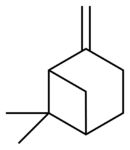beta-Pinene
 | |||
| |||
| Names | |||
|---|---|---|---|
| IUPAC name
6,6-Dimethyl-2-methylenebicyclo[3.1.1]heptane | |||
| Other names
2(10)-Pinene; Nopinene; Pseudopinene | |||
| Identifiers | |||
| 127-91-3 | |||
| 3D model (Jmol) | Interactive image | ||
| ChEBI | CHEBI:50025 | ||
| ChEMBL | ChEMBL501351 | ||
| ChemSpider | 14198 | ||
| ECHA InfoCard | 100.004.430 | ||
| KEGG | C09882 | ||
| PubChem | 14896 | ||
| UNII | 4MS8VHZ1HJ | ||
| |||
| |||
| Properties | |||
| C10H16 | |||
| Molar mass | 136.24 g·mol−1 | ||
| Appearance | Colourless liquid | ||
| Density | 0.872 g/mL | ||
| Hazards | |||
| R-phrases | R10 R36 R37 R38 | ||
| S-phrases | S26 S36 | ||
| NFPA 704 | |||
| Flash point | 36 °C (97 °F; 309 K) | ||
| Except where otherwise noted, data are given for materials in their standard state (at 25 °C [77 °F], 100 kPa). | |||
| | |||
| Infobox references | |||
beta-Pinene (β-pinene) is a monoterpene, an organic compound found in plants. It is one of the two isomers of pinene, the other being α-pinene. It is colorless liquid soluble in alcohol, but not water. It has a woody-green pine-like smell.
This is one of the most abundant compounds released by forest trees.[1] If oxidized in air, the allylic products of the pinocarveol and myrtenol family prevail.[2]
Plants that contain β-pinene
Many plants from many botanical families contain the compound, including:
- Cuminum cyminum[3][4]
- Humulus lupulus[5]
- Pinus pinaster[2]
- Clausena anisata
- Cannabis sativa
- Cannabis indica
See also
References
- ↑ Geron, C., et al. (2000). A review and synthesis of monoterpene speciation from forests in the United States. Atmospheric Environment 34(11), 1761-81.
- 1 2 Neuenschwander, U., et al. (2011). Peculiarities of β-pinene autoxidation. ChemSusChem 4(11), 1613-21.
- ↑ Li, R. and Z. T. Jiang. (2004). Chemical composition of the essential oil of Cuminum cyminum L. from China. Flavour and Fragrance Journal 19(4), 311-13.
- ↑ Wang, L., et al. (2009). Ultrasonic nebulization extraction coupled with headspace single drop microextraction and gas chromatography-mass spectrometry for analysis of the essential oil in Cuminum cyminum L. Analytica Chimica Acta 647(1), 72-77.
- ↑ Tinseth, G. The Essential Oil of Hops: Hop Aroma and Flavor in Hops and Beer. Brewing Techniques January/February 1994. Accessed July 21, 2010.
This article is issued from Wikipedia - version of the 6/21/2016. The text is available under the Creative Commons Attribution/Share Alike but additional terms may apply for the media files.
-(-)-beta-pinene-2D-projected-skeletal.png)
-(%E2%88%92)-beta-pinene-from-xtal-3D-balls.png)
